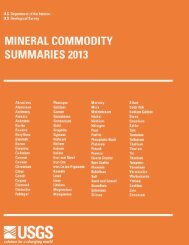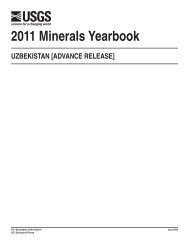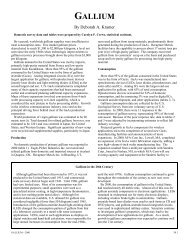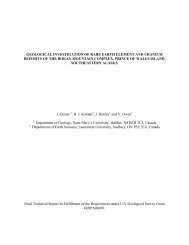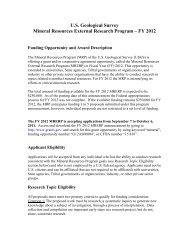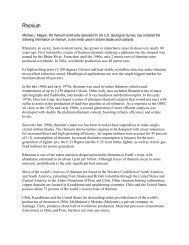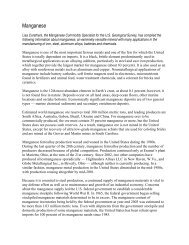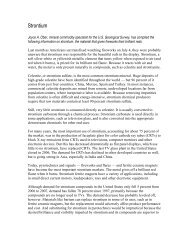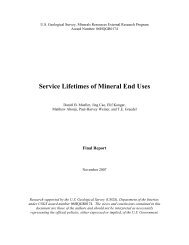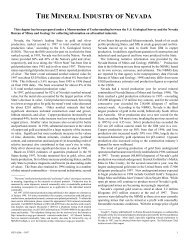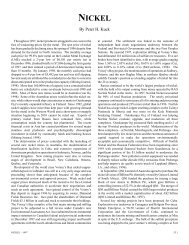Mineral Commodity Summaries 2003 - Mineral Resources Program ...
Mineral Commodity Summaries 2003 - Mineral Resources Program ...
Mineral Commodity Summaries 2003 - Mineral Resources Program ...
Create successful ePaper yourself
Turn your PDF publications into a flip-book with our unique Google optimized e-Paper software.
58<br />
DIAMOND (INDUSTRIAL)<br />
(Data in million carats, unless otherwise noted)<br />
Domestic Production and Use: In 2002, domestic production was estimated at approximately 310 million carats,<br />
and the United States remained the world’s largest market for industrial diamond. All domestic output was synthetic<br />
grit and powder. Two firms, one in New Jersey and the other in Ohio, accounted for all of the production. Nine firms<br />
produced polycrystalline diamond from diamond powder. Four companies recovered used industrial diamond as one<br />
of their principal operations. The following industry sectors were the major consumers of industrial diamond:<br />
computer chip production, construction, machinery manufacturing, mining services (drilling), stone cutting/polishing,<br />
and transportation systems (infrastructure and vehicles). Stone cutting and highway building and repair consumed<br />
most of the industrial stone. More than 90% of the industrial diamond market now uses synthetic industrial diamond,<br />
whose quality can be controlled and whose properties can be customized to fit specific requirements.<br />
Salient Statistics—United States: 1998 1999 2000 2001 2002 e<br />
Bort, grit, and dust and powder; natural and synthetic:<br />
Production:<br />
Manufactured diamond e<br />
140 208 248 308 310<br />
Secondary 10 10 10 10 8.4<br />
Imports for consumption 221 208 291 281 195<br />
Exports 1<br />
104 98 98 88 81<br />
Sales from Government stockpile excesses ( 2 ) ( 2 ) — — —<br />
Consumption, apparent 267 328 451 511 432<br />
Price, value of imports, dollars per carat<br />
Net import reliance<br />
0.44 0.44 0.39 0.31 0.34<br />
3 as a percentage of<br />
apparent consumption<br />
Stones, natural:<br />
Production:<br />
44 36 43 38 27<br />
Mine ( 2 ) ( 2 ) ( 2 ) ( 2 ) —<br />
Secondary 0.5 ( 2 ) ( 2 ) ( 2 ) ( 2 )<br />
Imports for consumption 4<br />
4.7 3.1 2.5 2.5 2.2<br />
Exports 1<br />
0.8 0.7 1.6 1.0 1.0<br />
Sales from Government stockpile excesses 0.8 0.6 1.0 0.5 0.4<br />
Consumption, apparent 5.2 3.4 2.2 2.2 1.8<br />
Price, value of imports, dollars per carat 3.92 4.61 5.31 3.54 5.43<br />
Net import reliance 3 as a percentage of<br />
apparent consumption 90 88 86 91 89<br />
Recycling: In 2002, the amount of diamond bort, grit, and dust and powder recycled was estimated to be 8.4 million<br />
carats. Lower prices and greater competition appear to be reducing the number and scale of diamond stone recycling<br />
operations; in 2002, it was estimated that 205 thousand carats of diamond stone were recycled.<br />
Import Sources (1998-2001): Bort, grit, and dust and powder; natural and synthetic: Ireland, 44%; China, 18%;<br />
Ukraine, 16%; and other, 22%. Stones, primarily natural: Switzerland, 21%; Russia, 20%; United Kingdom, 17%;<br />
Ireland, 13%; and other, 29%.<br />
Tariff: Item Number Normal Trade Relations<br />
12/31/02<br />
Miners’ diamond, carbonados 7102.21.1010 Free.<br />
Other 7102.21.1020 Free.<br />
Industrial diamond, natural advanced 7102.21.3000 Free.<br />
Industrial diamond, natural not advanced 7102.21.4000 Free.<br />
Industrial diamond, other 7102.29.0000 Free.<br />
Grit or dust and powder 7105.10.0000 Free.<br />
Depletion Allowance: 14% (Domestic and foreign).<br />
Prepared by Donald W. Olson [(703) 648-7721, dolson@usgs.gov, fax: (703) 648-7722]



